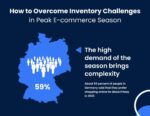Commercial collaboration
Flexible, scalable, and resilient
The demands on e-commerce platforms are constantly increasing. Customers expect a personalized, seamless, and secure customer experience, while companies increasingly face the challenge of quickly adapting their systems to new market conditions. Composable Commerce offers a modular architecture that meets these requirements while enabling greater flexibility and resilience.
The idea behind Composable Commerce and why it promotes resilience
Composable Commerce and MACH architecture (Microservices, API-first, Cloud-native, and Headless) describe the construction of e-commerce systems from independent, modular components or microservices. These enable specific functions such as payment processing, product information management, or customer service to be separated and combined or exchanged as needed. This ensures increased flexibility and adaptability in an increasingly dynamic and uncertain business world.
By decoupling individual functions, a system becomes more robust and resilient to unpredictable changes. This flexibility is particularly crucial during times of crisis, when companies need to adapt quickly without having to revise the entire system.
The ability to exchange individual components independently also increases responsiveness to new market requirements. In an increasingly volatile environment, where technological developments and customer requirements change rapidly, this represents a significant advantage. Companies can not only react more quickly but also integrate targeted innovations into the platform without taking major risks.
The modular approach of Composable Commerce: Implementation measures
To successfully implement Composable Commerce, it is necessary to switch from a monolithic system approach to a modular architecture. This can be achieved with a MACH architecture, where flexibly combinable building blocks can be individually assembled and quickly adapted. Practical examples of the modular approach include Algolia and Contentstack. Algolia integrates AI-powered search functions for fast and intelligent product searches in e-commerce platforms; Contentstack, as a headless CMS, offers the ability to centrally create content and flexibly distribute it to various channels via APIs. Both systems can be integrated into a modular architecture, creating an adaptable infrastructure that dynamically adjusts to business requirements.
The transition to such an architecture offers the opportunity to specifically optimize individual components and make them more flexible. To achieve this, existing systems should first be evaluated and analyzed to determine which components can function independently and be modularized.
Finally, through Composable Commerce, companies can implement the Best-of-Breed approach. Companies can select and combine the best available solutions from the best providers for specific functions of their e-commerce platform. This avoids relying on a single provider or becoming dependent on a single provider’s monolithic solution. This increases the degree of independence and reduces the risk of technological bottlenecks.
API-First architecture: The key to flexibility
A central pillar of Composable Commerce and MACH architectures, alongside microservices, cloud, and headless, is the API-First architecture. Standardized APIs therefore play a key role in implementing Composable Commerce: APIs (Application Programming Interfaces) enable various microservices and new functions to be seamlessly integrated into existing systems and allow individual modules of an e-commerce platform to be developed and managed independently. This creates the opportunity to quickly expand an existing platform without comprehensive system adjustments and without having to set up the system anew. This provides companies with the ability to remain flexible and adaptable and to integrate new services or functionalities as soon as they are needed.
Through the use of APIs, a future-proof foundation is also created that enables response to future technological developments. This architecture promotes greater agility and makes it possible to add new functions or replace existing ones with more efficient solutions at any time.
The flexibility of this architecture is particularly evident in its scalability. Companies can specifically expand only the modules necessary for business growth without affecting the overall system. This not only saves costs and resources but also ensures that the system remains more agile and robust.
Customer-centricity and rapid innovation cycles
One of the greatest advantages of Composable Commerce stems from improved customer-centricity. Through the modular structure, companies can develop customized solutions for their customers and specifically address specific needs. The flexibility of the modular approach therefore allows for better personalization of the customer experience and addressing individual customer requirements.
Furthermore, the modular architecture of Composable Commerce enables shorter innovation cycles. New functions and services can be integrated more quickly, which reduces time-to-market and increases competitiveness. The ability to quickly test and adapt innovations without compromising system stability ensures long-term customer retention and increases business success.
With Composable Commerce, companies can thus increase their innovative power while remaining flexible and agile to utilize new market opportunities more quickly. This also helps to secure long-term competitiveness by responding to customer wishes more quickly and continuously optimizing the platform.
Checklist: Criteria for Composable readiness
Before switching to a modular Composable Commerce architecture, however, companies should absolutely clarify important questions to ensure that their systems and processes are suitable for such a structure. A clear strategy and assessment of the existing IT infrastructure are crucial to master the transition. A checklist for evaluating Composable readiness must therefore include the following points:
- Long-term Strategy: Does the Composable Commerce approach support the company’s long-term business goals and future growth?
- Best-of-Breed Strategy: Is there already a strategy in place that allows selecting the best solution for each e-commerce function?
- ROI Assessment: Has a cost-benefit analysis been conducted to justify investments in Composable Commerce?
- IT Infrastructure: Is the existing infrastructure compatible with an API-First architecture? Can new modules be seamlessly integrated?
- Scalability: Is the system capable of scaling only the components required for growth?
- Data Architecture: How well is the existing data architecture organized to seamlessly integrate various data sources?
- Security Requirements: Are security and data protection requirements integrated into the new architecture?
- Flexibility: How quickly can existing systems be adapted without compromising stability?
- Resources and Expertise: Does the team have the necessary skills to implement and manage a modular architecture? Is there a need for external partners?
- Change Management: Is there a clear change management strategy to support the transition to a new system architecture?
Such a readiness check can, however, itself become an organizational hurdle and challenge for a company. Often, companies also lack the required know-how for successful implementation. In such cases, support from external partners is advisable and sensible, as they bring experience knowledge from numerous best practices of similar implementation cases and can apply them to the company. Not least, this also reduces the company’s own effort and increases the prospect of success for a successful system transition.
Conclusion
Composable Commerce offers companies the opportunity to make their e-commerce platform flexible, scalable, and resilient. The modular architecture enables quick integration of new innovations into the system, personalizing the customer experience, and responding to market changes without having to adjust the entire system. In summary, it can therefore be said that companies investing in Composable Commerce now are creating the foundation for long-term innovation capability and higher competitiveness.
This approach not only supports the current business strategy but also forms the basis for future-proof growth. Composable Commerce thus becomes a key technology for maintaining long-term success in the dynamic e-commerce market.
For readiness checks and system transitions, however, companies should rely on the expertise and best practices of external partners to reduce their own project effort on one hand and benefit from experience knowledge of previous implementations on the other. Finally, in tandem with external support, e-commerce companies can safely and successfully pursue the path to a future-proof Composable Commerce infrastructure.
Author: Tim Schüning, Strategy & Business Consultant at SQLI
Source: https://bit.ly/4jyKc4m
***




![Expert Insights on How to Improve Consumer Trust [The PwC Report]](https://ecommercegermany.com/wp-content/uploads/2024/06/pexels-olly-920382-150x100.jpg)
